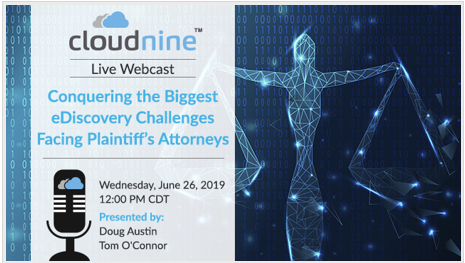Here’s a Webcast to Help Plaintiff’s Attorneys Conquer Their Biggest eDiscovery Challenges: eDiscovery Webcasts
As we learned in Tom O’Connor’s recent five part blog series, it seems as though the eDiscovery deck is stacked against plaintiff’s attorneys. Defendants seem to have all the resources, the technical know-how and the interest of the major eDiscovery vendors while the plaintiffs often have few resources, technical knowledge or eDiscovery experience. How do plaintiff’s attorneys bridge that gap? Here’s a webcast that will help put those plaintiff’s attorneys on a more equal footing with their defendant counterparts.
Wednesday, June 26th at noon CST (1:00pm EST, 10:00am PST), CloudNine will conduct the webcast Conquering the Biggest eDiscovery Challenges Facing Plaintiff’s Attorneys. In this one-hour webcast that’s CLE-approved in selected states, we will discuss the biggest eDiscovery challenges facing plaintiff’s attorneys and provide best practices for addressing those challenges to give plaintiff’s attorneys the best chance to get the evidence they need for their case. Topics include:
- Biggest eDiscovery Challenges Facing Plaintiff’s Attorneys
- Ethical Duties and Rules for Understanding Technology
- Does the eDiscovery Market Care About Plaintiff’s Attorneys?
- Understanding the Fundamentals of eDiscovery
- Your Clients May Have More ESI Than You Think
- How to Request the Right Form of Production from Opposing Counsel
- Mechanisms and Approaches for Getting the Data to Make Your Case
- What You Need to Know About Technology Assisted Review
- Resources You Need to Bridge Your Understanding Gap
As always, I’ll be presenting the webcast, along with Tom O’Connor, whose aforementioned white paper regarding the biggest eDiscovery challenges facing plaintiff’s attorneys was published last month on the blog. To register for it, click here. Even if you can’t make it, go ahead and register to get a link to the slides and to the recording of the webcast (if you want to check it out later). If you’re a plaintiff’s attorney looking to better handle eDiscovery challenges or a defense attorney wondering what “secrets” we’re passing onto those plaintiff’s attorneys, this webcast is for you!
So, what do you think? Are you a plaintiff’s attorney who feels that the eDiscovery deck is stacked against you? If so, please join us! If not, please join us anyway! And, as always, please share any comments you might have or if you’d like to know more about a particular topic.

Sponsor: This blog is sponsored by CloudNine, which is a data and legal discovery technology company with proven expertise in simplifying and automating the discovery of data for audits, investigations, and litigation. Used by legal and business customers worldwide including more than 50 of the top 250 Am Law firms and many of the world’s leading corporations, CloudNine’s eDiscovery automation software and services help customers gain insight and intelligence on electronic data.
Disclaimer: The views represented herein are exclusively the views of the author, and do not necessarily represent the views held by CloudNine. eDiscovery Daily is made available by CloudNine solely for educational purposes to provide general information about general eDiscovery principles and not to provide specific legal advice applicable to any particular circumstance. eDiscovery Daily should not be used as a substitute for competent legal advice from a lawyer you have retained and who has agreed to represent you.






